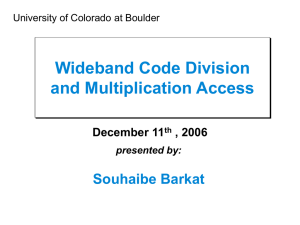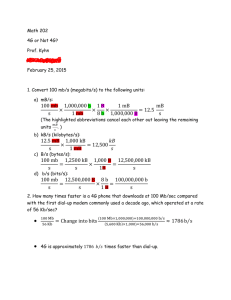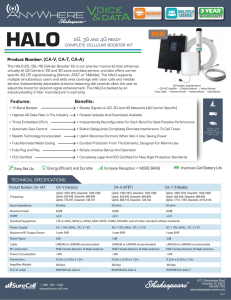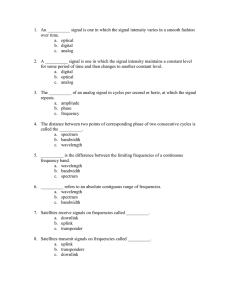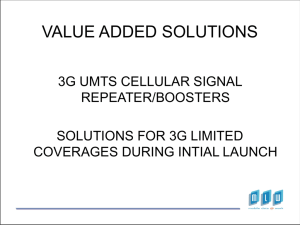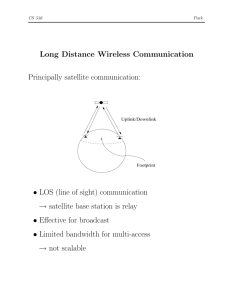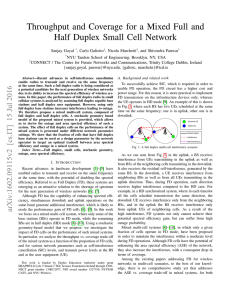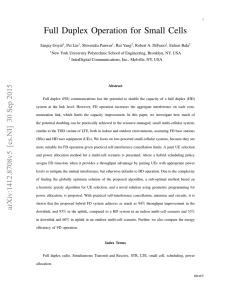WiFox: Scaling WiFi Performance for Large Audience Environments Arpit Gupta
advertisement
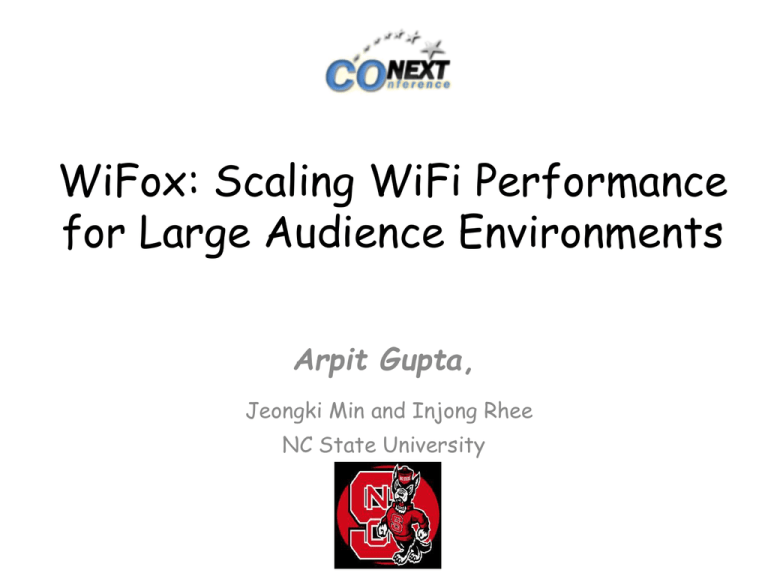
WiFox: Scaling WiFi Performance for Large Audience Environments Arpit Gupta, Jeongki Min and Injong Rhee NC State University Interesting ?? WiFox: AP-only S/W solution Faster WiFi !! Manageable solution !! Large Audience Environments (LAEs) Large Audience Environments • Any location with a large WiFi user population • WBA projected a growth rate of 350% per year for such WiFi deployments • Various successful deployment models such as Boingo-Google, Mobily-Aruba etc. already exist Source: WBA(Wireless Broadband Alliance) Source: Wireless Broadband Alliance (WBA) What about User Experience ? As number of active clients increases, user experience diminishes significantly Problem Anatomy Well Known Factors • Contention and collision – Increases with growing competition • Rate Diversity – Slower STA slows down all other STAs – Various fairness realizations like WFQ, TBR etc. • Random Losses and TCP performance – TCP treats packet losses as congestion signals – Usage of TCP ECN and proxy servers isolate wired and wireless networks • Traffic Asymmetry Traffic Asymmetry Downlink Traffic dominates for 90% of data traces Traffic Asymmetry Downlink Traffic dominates compared to uplink Majority of data traffic is Web based Majority of data packets are for HTTP based web activities Traffic Asymmetry • In scope of our problem it is: – Downlink/Uplink Asymmetry – Channel Access Asymmetry • Implications: – Packets spend more time at AP’s TxQ – Frequent packet drops Channel access for uplink traffic is more Wireless Channel Uplink Traffic Downlink Traffic Performance Bottleneck TxQ saturates as associated clients increase Associates Users Goodput Performance Traffic Asymmetry causes TxQ saturation resulting in poor goodput performance Possible Solutions Wireless Channel Uplink Traffic Downlink Traffic Equal Channel Access for Uplink/Downlink Wireless Channel Uplink Traffic Downlink Traffic Statically Assign Higher Priority to Downlink Traffic Wireless Channel Uplink Traffic Downlink Traffic Dynamically Assign Higher Priority to Downlink Traffic Our Solution Priority Control STA A STA B Packet A Class CWmin ACK CWmax AP STAs 1 5 DIFS Busy medium 5 10 AIFS TXOP Limit 1 64 N/A N/A N Slots Wins Contention Smaller IFS STA C Busy medium DIFS H N Slots Channel Access Linear Scaling Priority Model 35 Goodput (Mbps) 30 25 Linear20relationship between Goodput and Priority Level 15 10 Priority Level 5 0 0 2 4 6 8 Number of Slots with High Priority 10 Adaptive Prioritization Decision Points 100 ms Time Default Priority D H D H D D High Priority D Priority Level 3 H D D Evaluation Test Bed • 2600 Sqft Area with multiple APs, 45 STAs • Netgear 802.11 b/g wireless cards with Atheros chipsets and MADWIFI drivers • Latency emulation using DummyNet • Modified SURGE for web traffic generation • Requests inter-arrival closely follows the ones observed for SIGCOMM traces • Uplink UDP traffic using Iperf to emulate Background Traffic Performance Downlink: N/W Goodput W/O WiFox Significant improvement in Network’s Downlink Goodput WiFox Performance • Experiment involves sending 25 requests and observe response for 4 minutes duration • Request Serving rate is 4 times better than NPC Robustness WiFox Performance in presence of Multiple Aps ?? w/o WiFox Robustness w/o WiFox Unfair Distribution Fairness Realization ?? WiFox Performance: TxQ Dynamics w/o WiFox WiFox Conclusion • WiFox Delivers: – Deployment Ready Solution – Enhanced user experience with • 400-700% Downlink Goodput improvements • 40-60% faster response time • Open Problems: – Characterizing asymmetry problem for 802.11n – Support for real time applications like chats etc. – QoS Merci !! 30 Multi AP Scenario D D D D D D AP 1 ( Priority Level 4) D D D 100 ms D D D D AP 2 ( Priority Level 3) time D D D D D D AP 1 ( Priority Level 3) D D D D D AP 2 ( Priority Level 5) D Performance: Insight • Enables AP to switch to HIGH priority state under heavy load • Avoids TxQ saturation • Significant reduction in ReTx rate compared to stock WiFi implementation Robustness: Uplink Traffic • Scenarios where few users indulge in heavy uplink activities like video uploading, cloud synchronization etc. Observations Source: Rodrig et al.

